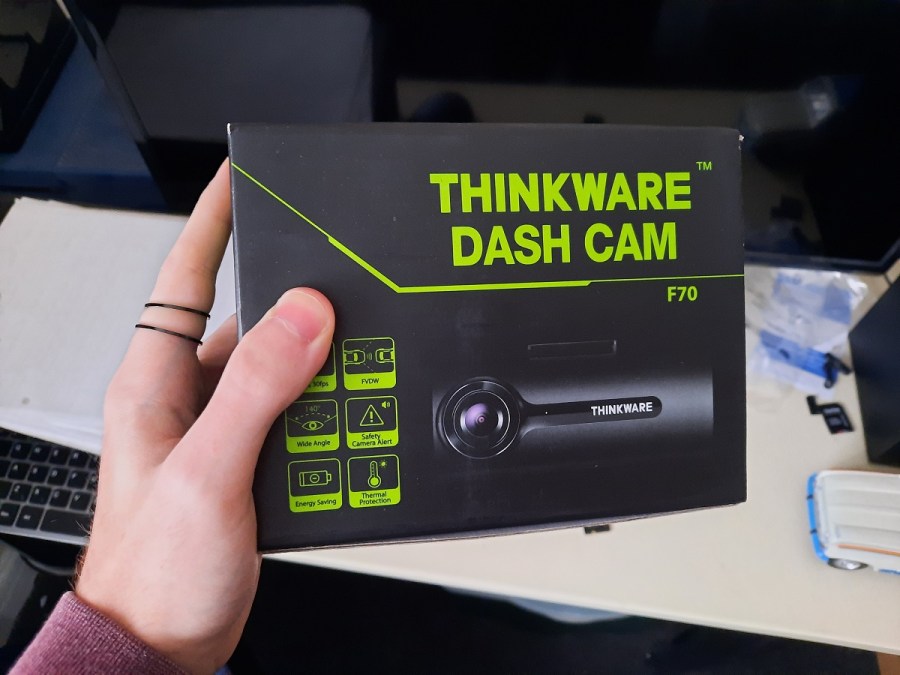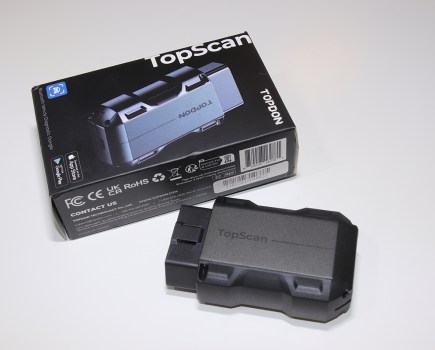If you want the basics from your dash cam setup – good image quality, and maybe parking mode or GPS – then you don’t have to spend an arm and a leg to get a product that’s up to the task. However, even at this end of the market, you’d be surprised how different certain options can be. So, have a read of this Thinkware F70 dash cam review to find out how this slim little device performs.
How we tested the product
It’s always important to get a holistic view of what it’s like to own each dash cam that I test. For that reason, I’ll be taking you through the whole ownership process – installation, operation, and showing you what sort of image quality you can expect at both day and night. Along the way, I’ll point out the good and bad that you only get to see when handling the dash cam first-hand.
I’ve done quite a number of these dash cam tests for Fast Car now, so I’m well-placed to advise you on how different brands of dash cam stack up against each other. What’s more, I’m an enthusiastic driver, so I’ve got a good idea about which details are important for a dash cam to pick up.
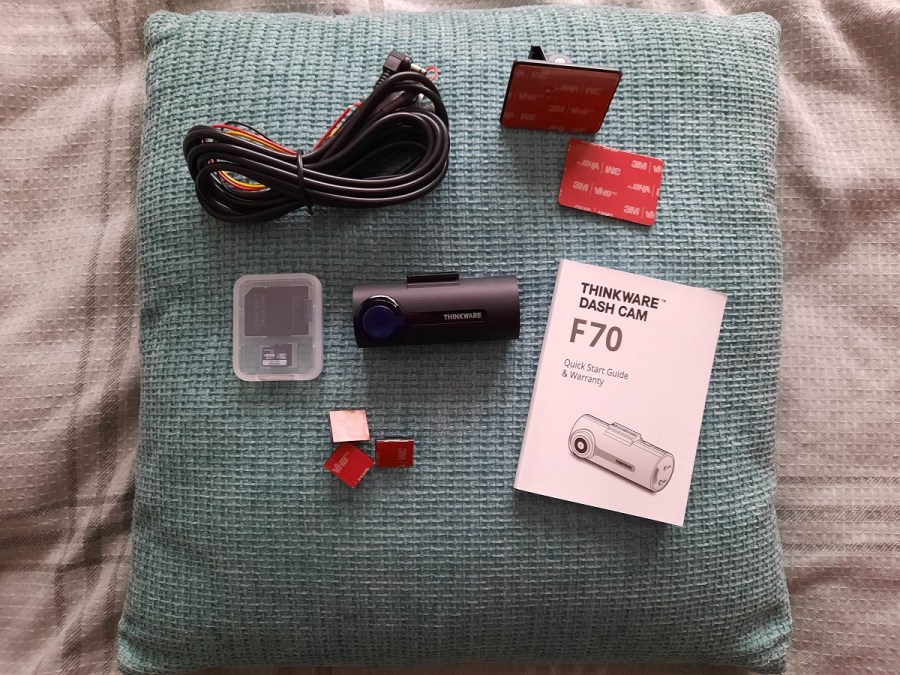
What’s in the box?
As ever, I’ll begin by guiding you through what comes in the box. Naturally, the camera itself is the centerpiece, but you also get Thinkware’s adhesive mounting system, a microSD card (which is quite rare to get included!) and a quick-start guide. The full manual is online. There are also adhesive clips designed to help you tuck the dash cam’s cables into place after installation, and you also get a spare adhesive pad for the mount. When purchasing your F70 online, you’ll get the choice of either a 12V car charger or hardwiring kit as its primary power source. However, an OBD2 power lead is also available at extra cost, and although in this case Thinkware supplied us with the hardwiring kit, I also have access to the OBD2 lead – so that’s what I’ll be using in this test.
Tech Specs:
- Resolution: 1080p at 30fps
- Field of View: 140 degrees
- Extra Features: G-sensor, parking mode-ready, vehicle departure warning
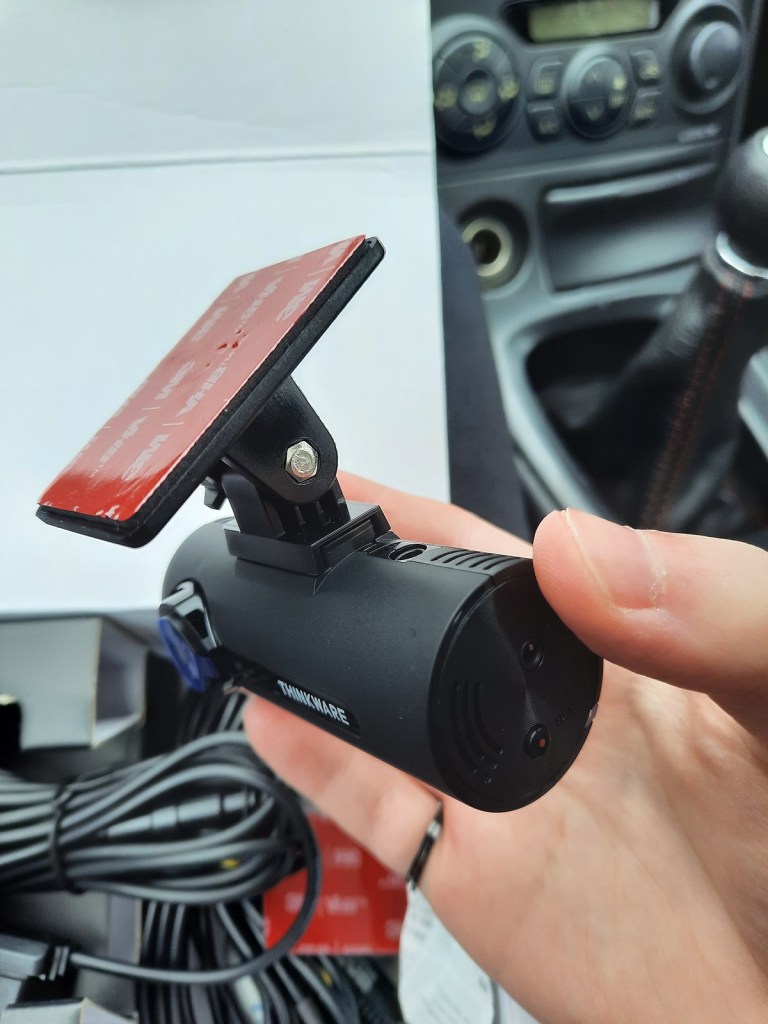
Thinkware camera mounts
I have a love-hate relationship with the mounting system that Thinkware uses in the F70 and X1000’s design. The slide-on mechanism to attach the camera to the mount is perfectly simple and effective, but adhering the mount to the windscreen is something which Thinkware devices always frustrate me with. The reason being is that they use a type of 3M adhesive which has a protective film that is anything but easy-peel. Admittedly, my nails are practically non-existent, but even still, it’s an oddly arduous task.
After 5 minutes of trying and failing to peel the darn film off, I eventually conceded defeat and used a scraper blade to get the job done. Maybe it’s just me, but across the board, Thinkware dash cams always end up being the least straight-forward to mount. It’s a small, quite specific gripe, but one which can make the installation process that little bit more frustrating and time-consuming.
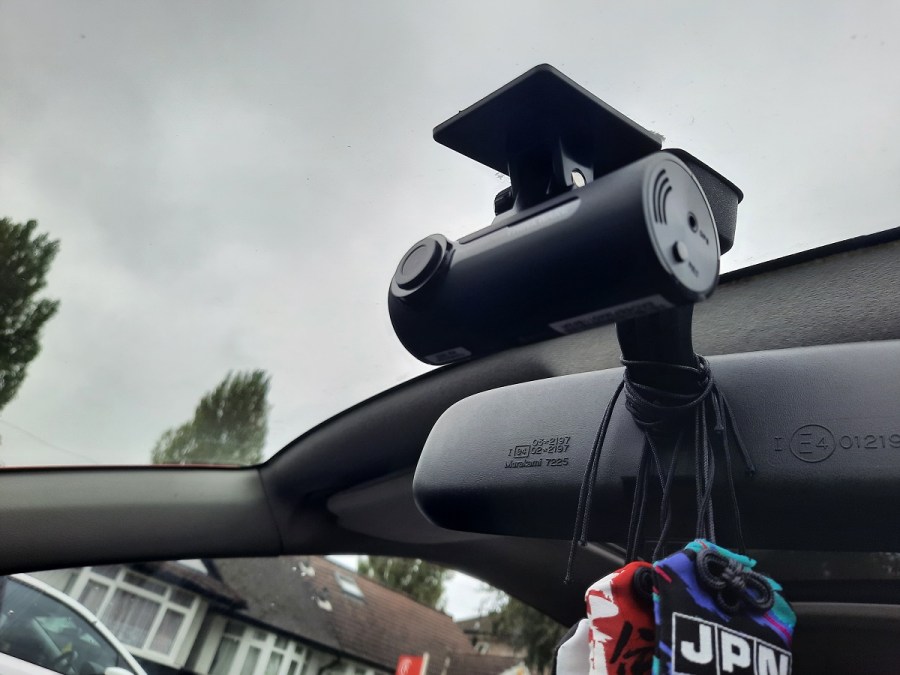
Positioning the camera
Once you’re able, it’s a good idea to position the camera high up and central on the inside of your car’s windscreen. That way, you’ll get the best footage, and the camera will cause the least amount of distraction. In fact, if you hide it behind the rearview mirror it won’t cause any distraction at all. This is especially true of the Thinkware F70 thanks to its slim, discreet design. When placing the mount, you might also want to take note of the fact that the F70’s lens is located to the side of the camera’s body. As such, if you want a perfectly central viewpoint, it may be worth offsetting the mount’s position a little.
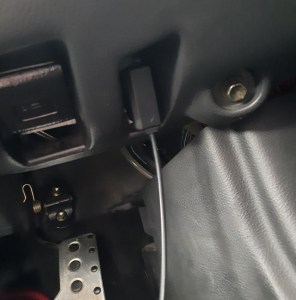
Connecting to power
As mentioned earlier, you can power the F70 by either connecting it to your car’s 12V charge port, or hardwiring it into the car’s electronic system. The third option is to use and OBD2 power cable (as shown above), which is a costlier – but much less invasive – way of achieving the same constant power objective as the hardwiring kit. This means that not only will the camera be operational when the car’s engine is running, but it’ll also be lying dormant in parking mode when you’re away from the car. In this scenario the in-built G sensor will wake the camera up when it identifies an impact. More on that later…
Daytime image quality
Right then, with everything set up, the next stage of the test involved getting out on the road and assessing the quality of the recordings that the camera picked up. I should mention that the F70 was tested in its default settings, meaning a resolution of 1080p at 30fps, with a 140-degree viewing angle. At a glance, I’m sure you’ll agree that the image quality is perfectly reasonable. The picture is crisp enough and all the fine details like vehicle license plates and facial features are legible when you pause the video.
What it does lack though, is GPS. You can enhance your F70 with a GPS add-on, but at its core, it doesn’t have that tech built-in. As such, its recordings aren’t accompanied by location and speed data as standard. That might be a bit of a blow in the event of a legal case, but isn’t totally out of the ordinary for entry-level dash cams.
Night image quality
As with every camera, night time presents a much more difficult set of conditions for the Thinkware F70. However, it still does a pretty decent job. When casually viewing, it picks up a lot of the larger details, and captures the finer ones too if there’s minimal motion involved. However, it’s when you start actively looking at the reg plates of other cars, or signposts, when you realize that actually the picture isn’t quite so clear. But, no matter how much money you spend on a dash cam, you’re likely to encounter that problem.
Glare is another prominent issue with night time recording, and it’s definitely present here. Although not a dealbreaker, the glare (and interior reflection, for that matter) is exacerbated by the F70’s lack of polarizing lens filter. Again though, that’s sort of tech isn’t found on its rivals at this price point either. So, overall, while you can pick holes in its performance, the F70 is roughly on par with its nearest competitors.
Impact Detection and Parking Mode
As far as additional features go, the Thinkware F70 is quite a simple device. Again, it’s an entry-level product, so literally anything is a bonus. One thing that it does have up its sleeve though is a G sensor. This bit of tech helps the camera to identify impacts, and when that happens, it stores a recording of that moment in a separate folder. As you’d expect, this feature is operational when you’re driving about, but it also forms the basis of ‘parking mode’. As explained earlier, this is the camera’s dormant state which allows it to capture incidents upon impact when you’re away from the car. In its default settings though, there is a bit of a catch…
See, while using the F70, I found the G sensor to be overly sensitive. In the clip above, you can hear it beep as I go over a speed bump at a reasonable speed. But even when travelling over much less severe bumps, it’ll occasionally trigger when you’re travelling at motorway speeds. Now, for context, my car’s suspension isn’t exactly the softest. But it’s not hardcore, it’s just a worn stock setup from 2005. To me, that shouldn’t be enough to trigger an impact detection. It’s not the end of the world though, as you can lessen the sensitivity in the settings. Plus, it does at least give me an easy way to demonstrate the effectiveness of how the G sensor would work in parking mode.
Verdict
So, the Thinkware F70. Put simply, it’s a no-nonsense dash cam that just focuses on the basics, and to be honest I quite like that. I often find all the added extra features and functions of high-end dash cams to be a little gimmicky. It records decent footage at daytime and night and has a pleasingly discreet, slimline design. The mounting process is probably my biggest personal grievance, though maybe you’d have better luck with it. It’s a shame that GPS is absent too. Plus, while that G sensor is very oversensitive out of the box, it’s better to have that and turn it down a notch, rather than have a sensor which is oblivious to everything. The retail price is competitive, but not a bargain per se.
If you’re after a ‘my first dashcam’, then I’d recommend this one as it’s a good introduction to the market. However, more seasoned dash cam users should probably look elsewhere.

